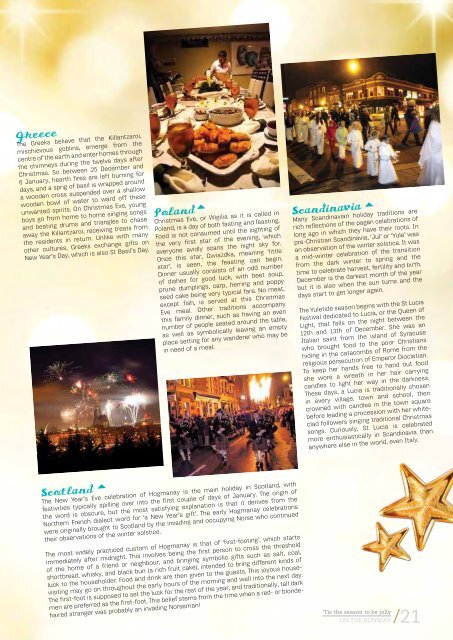2 - QVI Club
2 - QVI Club
2 - QVI Club
You also want an ePaper? Increase the reach of your titles
YUMPU automatically turns print PDFs into web optimized ePapers that Google loves.
Greece<br />
The Greeks believe that the Killantzaroi,<br />
mischievous goblins, emerge from the<br />
centre of the earth and enter homes through<br />
the chimneys during the twelve days after<br />
Christmas. So between 25 December and<br />
6 January, hearth fires are left burning for<br />
days, and a sprig of basil is wrapped around<br />
a wooden cross suspended over a shallow<br />
wooden bowl of water to ward off these<br />
unwanted spirits. On Christmas Eve, young<br />
boys go from home to home singing songs<br />
and beating drums and triangles to chase<br />
away the Killantzaroi, receiving treats from<br />
the residents in return. Unlike with many<br />
other cultures, Greeks exchange gifts on<br />
New Year’s Day, which is also St Basil’s Day.<br />
Poland<br />
Christmas Eve, or Wigilia as it is called in<br />
Poland, is a day of both fasting and feasting.<br />
Food is not consumed until the sighting of<br />
the very first star of the evening, which<br />
everyone avidly scans the night sky for.<br />
Once this star, Gwiazdka, meaning ‘little<br />
star’, is seen, the feasting can begin.<br />
Dinner usually consists of an odd number<br />
of dishes for good luck, with beet soup,<br />
prune dumplings, carp, herring and poppy<br />
seed cake being very typical fare. No meat,<br />
except fish, is served at this Christmas<br />
Eve meal. Other traditions accompany<br />
this family dinner, such as having an even<br />
number of people seated around the table,<br />
as well as symbolically leaving an empty<br />
place setting for any wanderer who may be<br />
in need of a meal.<br />
Scandinavia<br />
Many Scandinavian holiday traditions are<br />
rich reflections of the pagan celebrations of<br />
long ago in which they have their roots. In<br />
pre-Christian Scandinavia, ‘Jul’ or ‘Yule’ was<br />
an observation of the winter solstice. It was<br />
a mid-winter celebration of the transition<br />
from the dark winter to spring and the<br />
time to celebrate harvest, fertility and birth.<br />
December is the darkest month of the year<br />
but it is also when the sun turns and the<br />
days start to get longer again.<br />
The Yuletide season begins with the St Lucia<br />
Festival dedicated to Lucia, or the Queen of<br />
Light, that falls on the night between the<br />
12th and 13th of December. She was an<br />
Italian saint from the island of Syracuse<br />
who brought food to the poor Christians<br />
hiding in the catacombs of Rome from the<br />
religious persecution of Emperor Diocletian.<br />
To keep her hands free to hand out food<br />
she wore a wreath in her hair carrying<br />
candles to light her way in the darkness.<br />
These days, a Lucia is traditionally chosen<br />
in every village, town and school, then<br />
crowned with candles in the town square<br />
before leading a procession with her whiteclad<br />
followers singing traditional Christmas<br />
songs. Curiously, St Lucia is celebrated<br />
more enthusiastically in Scandinavia than<br />
anywhere else in the world, even Italy.<br />
Scotland<br />
The New Year’s Eve celebration of Hogmanay is the main holiday in Scotland, with<br />
festivities typically spilling over into the first couple of days of January. The origin of<br />
the word is obscure, but the most satisfying explanation is that it derives from the<br />
Northern French dialect word for ‘a New Year’s gift’. The early Hogmanay celebrations<br />
were originally brought to Scotland by the invading and occupying Norse who continued<br />
their observations of the winter solstice.<br />
The most widely practiced custom of Hogmanay is that of ‘first-footing’, which starts<br />
immediately after midnight. This involves being the first person to cross the threshold<br />
of the home of a friend or neighbour, and bringing symbolic gifts such as salt, coal,<br />
shortbread, whisky, and black bun (a rich fruit cake), intended to bring different kinds of<br />
luck to the householder. Food and drink are then given to the guests. This joyous housevisiting<br />
may go on throughout the early hours of the morning and well into the next day.<br />
The first-foot is supposed to set the luck for the rest of the year, and traditionally, tall dark<br />
men are preferred as the first-foot. This belief stems from the time when a red- or blondehaired<br />
stranger was probably an invading Norseman!<br />
‘Tis the season to be jolly<br />
ON THE RUNWAY /21











